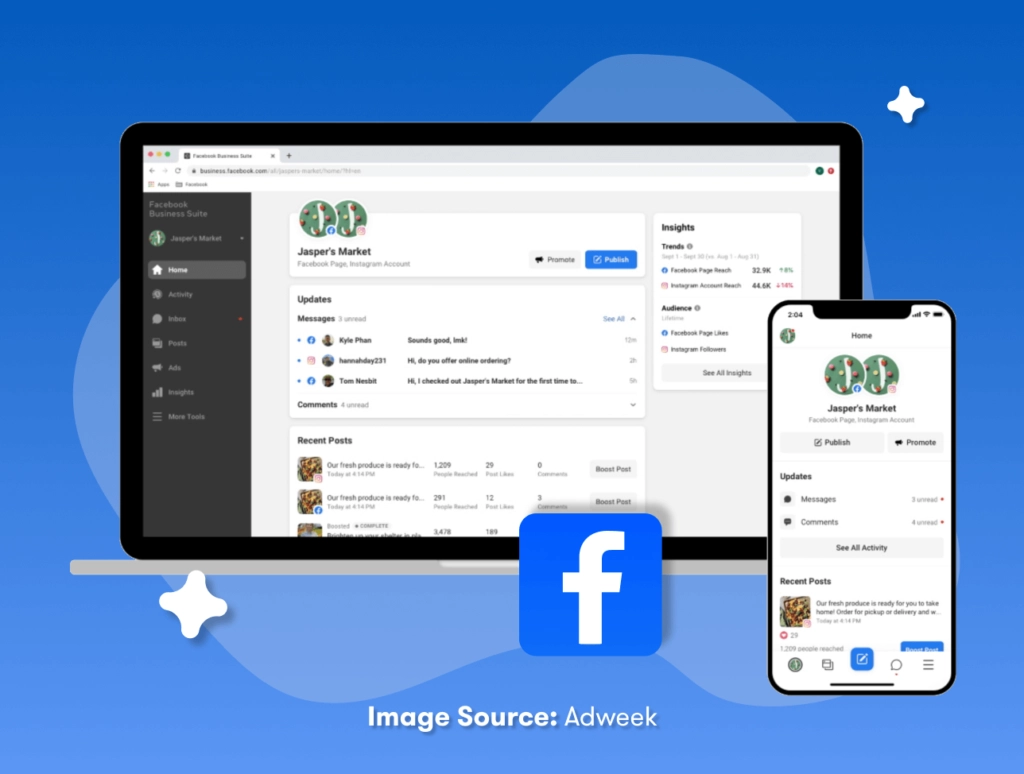7 Easy Tips To Manage Your Social Media Plan for SME?
Blog Categories:
Published:
May 4, 2023
Reading Time:
9 minutes

Social media is the king of communication, no doubt. The main proportion of consumers, Millennials and Gen Z, spend hours surfing the Internet to find the perfect brands. This is a goldmine for small and medium businesses (SMEs) to expand their influence and bring their names to a new level.
However, even though you have drawn a strategy, it is still challenging to put it into practice in today's ever-changing market. So, the million-dollar question is how to efficiently manage your social media plan, and we’re here to help you answer it.
However, even though you have drawn a strategy, it is still challenging to put it into practice in today's ever-changing market. So, the million-dollar question is how to efficiently manage your social media plan, and we’re here to help you answer it.
I. The role of social media plans for SME
1. The importance of an effective social media plan
A social media plan is the key to utilizing your social channels to the fullest. It illustrates what and how social platforms can generate results according to your target. By using this framework, your team can run and adjust their performance synchronously to ensure success.Creating a compelling social marketing plan benefits both directions: How you sell and how consumers buy from you. Let’s dig deeper into some of the biggest impacts of running captivating social strategies.

The most noticeable effect is on the brands' image. Half of the globe (4.76 billion people to be exact) are social media users, so advertising your brands on Facebook or TikTok can reach thousands of target audiences, especially if the company focuses on young generations. 9 out of 10 firms assert that running a suitable social marketing plan is a key factor in increasing brand exposure.
Taking advantage of these channels creates a user-friendly presence for future customers, as they can interact more with the brand in simple and familiar ways. Consumers are also more eager to connect with brands through social media, as 76% of shoppers are willing to communicate with potential providers through these channels.
These behaviors from shoppers don't go unnoticed by businesses. More than 50 million SMEs are taking advantage of their Facebook page to get in touch with potential buyers. Multiple small businesses choose social media as their quickest method of supporting customers and announcing new decisions.

Besides popular selling channels such as eCommerce or brick-and-mortar stores, social selling opens new bridges to connect with customers, thereby generating better revenue for small businesses. At the moment, the rise of Facebook Marketplace and TikTok Shop is the strongest proof of social media's power over consumers.
Researchers report that social media doubles the lead-close rate compared to traditional outbound marketing. Buyers are also happy to spend 20% to 40% more value on businesses that actively interact with them on these platforms. 71% of customers who are satisfied with their experience coming from the brand's social interaction are likely to introduce it to other people, thus becoming both loyal shoppers as well as passive advertisers of the brand.
Moreover, when you know how to utilize social marketing, it will greatly affect your budget distribution. Rather than spending a fortune on impractical methods that only sound great on paper, you can focus on channels you are familiar with. Most social platforms are free of charge, so in some cases when you have a suitable plan, you don't have to worry about financial problems!
KEY TAKEAWAYS
- Understanding the power of social channels is necessary to ensure SMEs' success online.
2. What makes an ideal plan
An effective social media plan consists of 4 main elements: Goals, Metrics, Channels, and Content.

Goals are what you want to achieve through social media marketing. There are different targets depending on your needs, such as revenue, brand exposure, or customer nurture. It is suggested that you should create a SMART goal (Specific, Measurable, Achievable, Realistic, and Time-sensitive).
Metrics are measurements used to calculate and analyze social campaign performance. It can be customers' reactions, the number of orders, or the messages your business receives.
Channels are the platforms you choose to reach your target audience. They can be Facebook, Instagram, TikTok, or other social media channels friendly to your customers. Usually, effective social media plans use several channels to maximize effects. This results in 91% of retail brands optimizing at least two platforms in their marketing activities.
Content determines which type is most suitable for your requirements. Some popular forms of content are posts, images, videos, and reels/stories. Similar to channels, the marketing team likes to combine the power of multiple content types to convey the message in the most customer-engaging way.
Other factors, such as budget and trends, can also affect your strategies, but these four are the most influential.

Goals are what you want to achieve through social media marketing. There are different targets depending on your needs, such as revenue, brand exposure, or customer nurture. It is suggested that you should create a SMART goal (Specific, Measurable, Achievable, Realistic, and Time-sensitive).
Metrics are measurements used to calculate and analyze social campaign performance. It can be customers' reactions, the number of orders, or the messages your business receives.
Channels are the platforms you choose to reach your target audience. They can be Facebook, Instagram, TikTok, or other social media channels friendly to your customers. Usually, effective social media plans use several channels to maximize effects. This results in 91% of retail brands optimizing at least two platforms in their marketing activities.
Content determines which type is most suitable for your requirements. Some popular forms of content are posts, images, videos, and reels/stories. Similar to channels, the marketing team likes to combine the power of multiple content types to convey the message in the most customer-engaging way.
Other factors, such as budget and trends, can also affect your strategies, but these four are the most influential.
II. 7 Tips to manage your social media plan
Unfortunately, building a social marketing strategy relying only on the aforementioned checklist will not guarantee success. The way you handle your idea in practical situations determines whether it will win or bust. Therefore, here are seven tips to help you manage your social media plan more efficiently in real-life situations.
1. Understand the market
To win a battle, it's essential to know your enemy. In business, you cannot achieve new heights if you don't comprehend the market. The online world is where users can access multiple brands at the same time or get exposed to new opportunities through smart-learning advertisements and interactive posts on their walls. Conveying your message clearly and uniquely will give you a huge edge. Social listening to your niche business will improve your social marketing and overall performance.Market understanding includes thorough research into your target audience, competitors, and current goals. You should ask yourself some of these questions:
- Who are your customers? How would you describe their demographics, interests, and challenges?
- Which channels are easiest to connect with your target audience?
- Which platforms are most suitable for your products/services?
- Are you familiar with those channels?
- What are your unique selling points (USPs) and messages best expressed through social media?
- Which platforms are your competitors using?
- Are there partners or influencers that can cooperate with your activities? How can they fit into the plan?
2. Analyze your data
It is impossible to expect the same reaction across all the social channels you run. That is why you need to analyze each platform's data, compare them and figure out which is the most appropriate channel or points that need to be altered. From these evaluations, you can adjust the plan to suit the market.You should put into consideration these numbers:
- Interactions (like, comment, share, etc.)
- New subscribers and unsubscribers
- Direct messages
- The budget and resources you spend on each channel
- The time and location that generate most interactions
3. Make use of technology
Social media management can be made easier by technology in the 4.0 era. Hundreds of tools are developed to support digital marketers in simplifying repetitive tasks such as scheduling posts, answering generic questions, or automatically generating reports periodically. For example, Facebook Business Suite is the hub for admins to control all actions on the Facebook page and connected Instagram account. Just in one interface, you can write original posts, schedule content, publish them across Facebook and Instagram, manage inboxes, and create ads.
Other than the free and built-in controllers within the platform, there are multiple outsider providers to support specific needs for social channel optimization. You can check out these types of tools to manage your social media plan effectively:
- Automatic tools for scheduling and posting content, such as Hootsuite
- Analyzing tools to keep track of and evaluate your accounts' performance and advertisements
- AI tools for advanced productivity. For instance, chatbots can remain online at all times and support customers 24/7
- Visual creator tools to help you quickly generate attractive images and videos for each platform
4. Take advantage of social media advertisements
Some small businesses seem to forget the role of advertisements on social media, due to a tight budget or simply not seeing the potential of it. This underestimation can come back and bite them in the end, as 49% of shoppers tend to purchase from advertisers on social media. In the current intense battle to grasp customers' attention, not promoting your image can keep you behind the game, where other competitors have reached closer to more and more potential buyers.
Furthermore, with the development of algorithms, social media advertisements are getting more intelligent than traditional channels. Almost all social channels support advertising on their platforms. Some prominent names are Facebook, Instagram, Twitter, TikTok, and LinkedIn. Therefore, it is not too late to start promoting your business on social media with an affordable and practical plan.
5. Be real and engage with customers
Although you can rely on technology to speed up your process, customers don't want to interact with bots all the time. That's why it's a matter of life and death to be genuine on social media, where personal characteristics are highly appreciated. You need to create a warm and welcoming environment for customers so they can see themselves as part of your brand. This is imperative to create lovable brand images and loyal customers.
Here are some ways to show your brand's social media engagement:
- Share customers' feedback on your wall
- Always answer their questions
- Do not ignore negative comments, turn them into constructive criticism
- Actively reach out to customers through social media
- Encourage them to join your events on social channels, or mention you in their social posts
6. Focus on the quality
Whether your plan is big or small, the essence lies in its quality. You can bombard customers with 10 or even 20 posts a day, however, if they cannot reach your goal, those posts are worthless. To ensure an effective social media plan, it's crucial to create specific content for each channel. For example, photos are best suited for Instagram posts, yet Reels and Stories should be short videos.Likewise, the team should also be divided into each step of creating content. The professional process will help you trace back to the point where things need to be changed. Content generation consists of three main phases: Manage/Plan, Create, and Edit. If you organize and follow these steps smoothly, you can see the difference in your social performance from day to day.
7. Catch up with the trends
The human attention span is 8.25 seconds. Thus it is a tricky problem to attract potential customers on social media since there is a constant flow of information that appears and disappears. So besides creating high-quality content, one way to increase the chance your social posts catch customers' eyes is by using trending topics. It won't be the first time customers see an advertisement or post mimicking a hot story at the moment. With these posts related to a trend, you can easily engage with customers and smartly convey your message.Conclusion
Compared to huge enterprises with more capital, smaller businesses need to optimize what they already have. It is unnecessary to emphasize again the importance of social media in the rise and fall of SMEs. The key to winning this game is managing your social media plan effectively.
Through this article, we hope we have shed light on several helpful tips to transform your social performance. There are still lots of unanswered questions, so Consultport is here to support you on the journey ahead! Consultport provides highly experienced consultants and digital experts to work with businesses on refining and optimizing their social media management. Contact us today to step up your social marketing and selling game!
Through this article, we hope we have shed light on several helpful tips to transform your social performance. There are still lots of unanswered questions, so Consultport is here to support you on the journey ahead! Consultport provides highly experienced consultants and digital experts to work with businesses on refining and optimizing their social media management. Contact us today to step up your social marketing and selling game!
Share This Story, Choose Your Platform!



